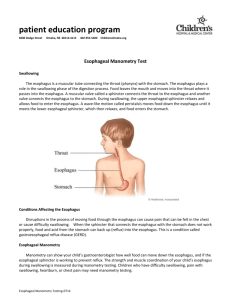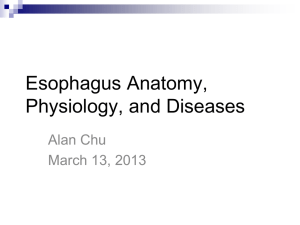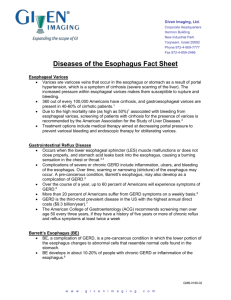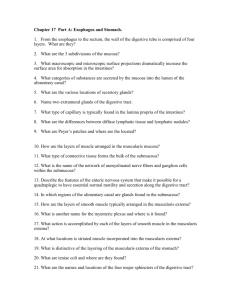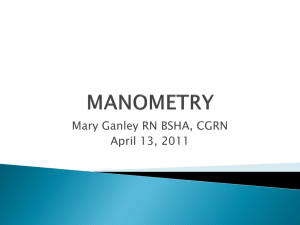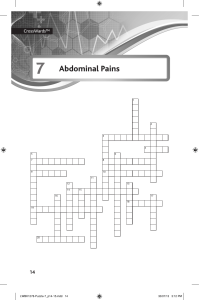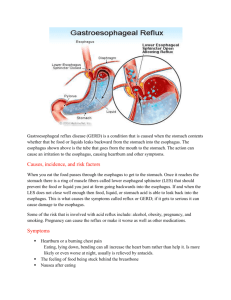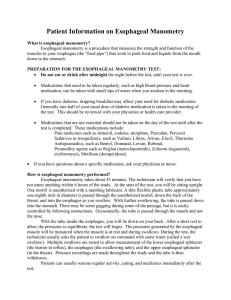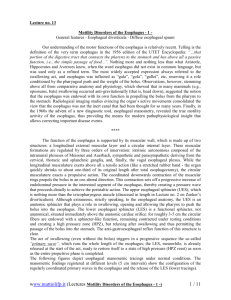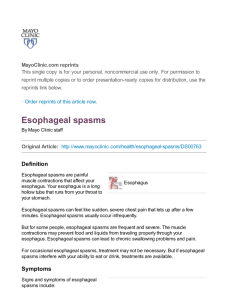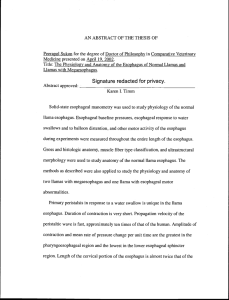43 Esophagus
advertisement
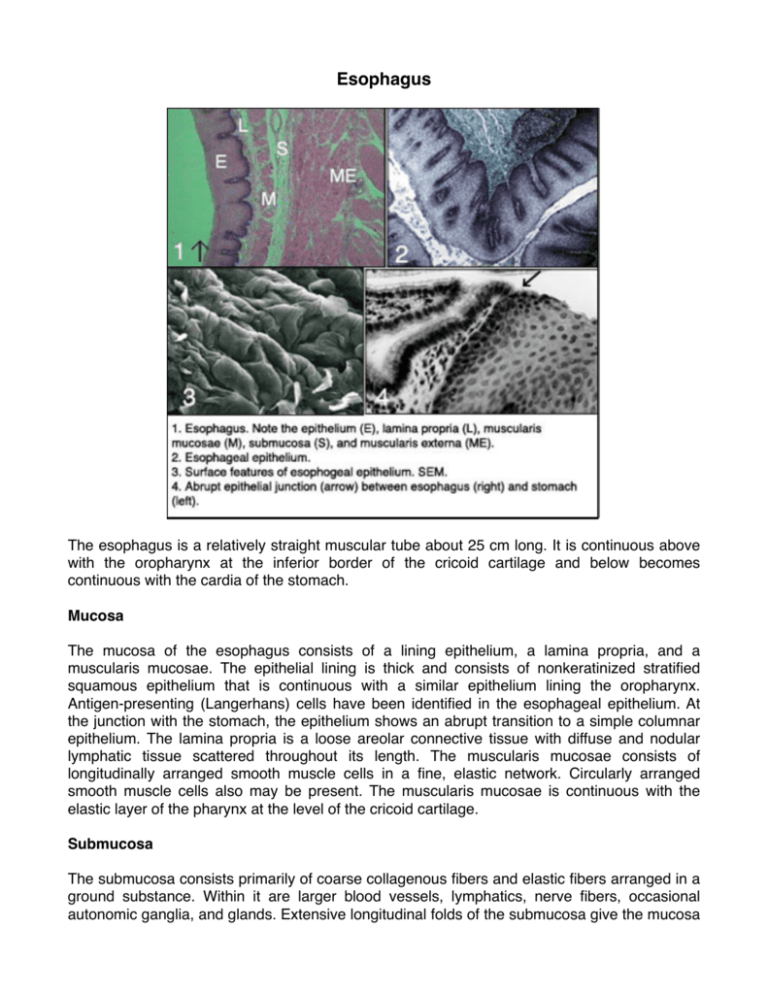
Esophagus The esophagus is a relatively straight muscular tube about 25 cm long. It is continuous above with the oropharynx at the inferior border of the cricoid cartilage and below becomes continuous with the cardia of the stomach. Mucosa The mucosa of the esophagus consists of a lining epithelium, a lamina propria, and a muscularis mucosae. The epithelial lining is thick and consists of nonkeratinized stratified squamous epithelium that is continuous with a similar epithelium lining the oropharynx. Antigen-presenting (Langerhans) cells have been identified in the esophageal epithelium. At the junction with the stomach, the epithelium shows an abrupt transition to a simple columnar epithelium. The lamina propria is a loose areolar connective tissue with diffuse and nodular lymphatic tissue scattered throughout its length. The muscularis mucosae consists of longitudinally arranged smooth muscle cells in a fine, elastic network. Circularly arranged smooth muscle cells also may be present. The muscularis mucosae is continuous with the elastic layer of the pharynx at the level of the cricoid cartilage. Submucosa The submucosa consists primarily of coarse collagenous fibers and elastic fibers arranged in a ground substance. Within it are larger blood vessels, lymphatics, nerve fibers, occasional autonomic ganglia, and glands. Extensive longitudinal folds of the submucosa give the mucosa of the non-distended esophagus a characteristic pleated appearance. During swallowing the bolus of food smoothes out these folds and allows the lumen to increase in size temporarily to accommodate the material swallowed. Muscularis Externa The upper quarter of the muscularis externa consists of skeletal muscle only. From the lower border of the inferior constrictor muscle of the pharynx, the muscle progressively becomes more regularly arranged into inner circular and outer longitudinal layers. In the second quarter of the esophagus, mixed skeletal and smooth muscle is found, while in the distal one-half, only smooth muscle is present. Histochemical studies suggest that the skeletal muscle fibers of the esophageal wall are type IIa, fast contracting, fatigue-resistant fibers. Nerve cells of the autonomic ganglia (Auerbach’s plexus) are present between the inner and outer layers of smooth muscle. Zones of intraluminal high pressure occur at the ends of the esophagus and are referred to as the upper esophageal sphincter (UES) and the lower esophageal sphincter (LES). Both are physiologic rather than anatomic sphincters, and normally, the intraluminal pressure generated by the LES is sufficient to prevent reflux of gastric contents into the esophageal lumen. In some individuals, the LES fails, and the mucosa of the lower esophagus is chronically subjected to gastric acid and pepsin. A chemically induced chronic esophagitis results, and the esophageal epithelium undergoes metaplasia, changing from wet stratified squamous to a simple columnar epithelium similar to gastric lining epithelium. Such a condition (Barrett's esophagus) may result in severe ulceration of this area. This condition is known as gastroesophageal reflux disease (GERD). The upper esophageal sphincter functions to keep air from entering the proximal esophagus. The hormone gastrin acts to stimulate the constriction of the lower esophageal sphincter. Adventitia A layer of loosely arranged connective tissue, the adventitia, covers the outer surface of the esophagus and binds it to surrounding structures. Below the diaphragm a short segment of the esophagus is covered by a serosa. Glands Two types of glands are present in the esophagus: esophageal cardiac glands and esophageal glands proper. Two groups of esophageal cardiac glands are present: one group located in the proximal esophagus near the pharynx, the other in the distal esophagus near the cardia of the stomach. Both are compound tubuloacinar glands of mucous type and occur only in the lamina propria. The esophageal glands proper also are mucous producing compound tubuloacinar glands but are confined to the submucosa and scattered throughout the remaining length of the esophagus. Lysozyme and pepsinogen have been identified in some but not all of the secretory cells. Myoepithelial cells are associated with the secretory units of human esophageal glands. ©William J. Krause
